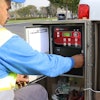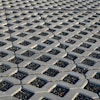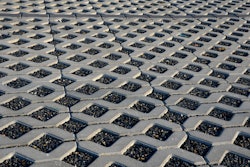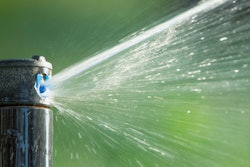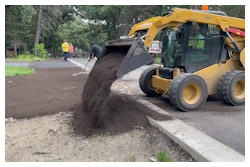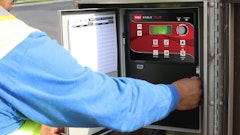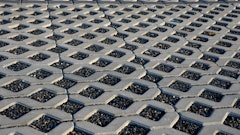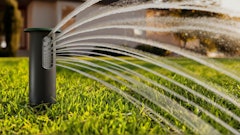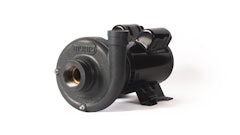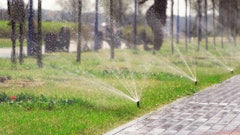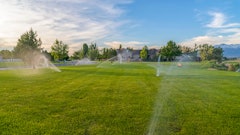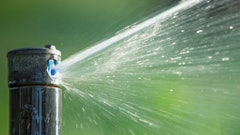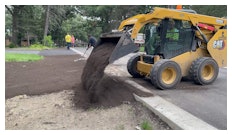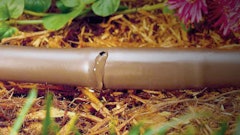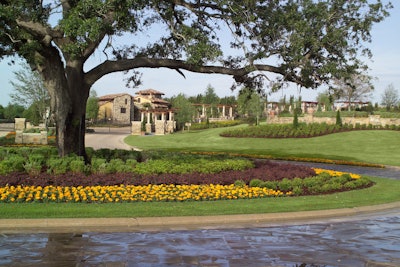
Anyone who has enjoyed the view of a beautifully maintained landscape knows the value of healthy, green grounds. Parks, campuses, and civic spaces with attractive landscapes are an asset to any community, but those managing these areas are facing growing pressure to reduce water use. At least a third of U.S. states, especially those in the western half of the country, are implementing some form of water restrictions. The pressure is on to find solutions that do more with less. The challenge is to bring to life green spaces that are both welcoming and water-efficient.
In commercial landscaping, the most commonly used irrigation system remains the in-ground sprinkler system. This irrigation system is known to lose as much as 50 percent of the water used due to wind, evaporation, and runoff. The more efficient solution is modern precision drip irrigation that is engineered for longevity, compliance, and real-world performance.
In high-profile public areas, precision irrigation is demonstrating it’s a better solution. First introduced to the U.S. in the mid-1980s, drip systems have proved their effectiveness. Some of the early installations, like those in Greenwich, Connecticut, are still operating four decades later. That kind of longevity speaks to drip irrigation's durability and effectiveness.
Traditional spray systems water indiscriminately from above, where much of the liquid evaporates, while drip applies water slowly and directly at or just below the soil surface. This is where roots absorb it best, and this level of precision provides the critical difference for water budgets and plant health. Overhead spray systems often reach just 50 to 65 percent levels of efficiency, but modern drip products are documented to reach as high as 95 percent efficiency, a huge difference in resource savings.
Beyond water savings, drip systems eliminate typical problems associated with above-ground sprinklers. In public spaces like office parks, plazas, or civic greens, spray heads create safety hazards or are vandalized. With subsurface drip, there is no raised hardware, which means no tripping hazards or unsightly broken fixtures, solving what many managers refer to as the “attractive nuisance” problem.
More about drip irrigation on GreenIndustryPros.comTaking Control of Your Irrigation System - A look at the benefits of irrigation controllers and how irrigation pros can take advantage of them. It's Not What You Water—It's How You Water - By changing up their watering tactics, irrigation pros can make a real difference. Adapting Landscape Design in Drought-Stricken Areas - Texas company talks about how they are planning more efficient landscaping during droughts. |
Tackling the Misconceptions
Despite its documented benefits in a variety of demanding conditions, commercial adoption of drip has been slow. Technology has made major strides. Pressure-compensating emitters deliver consistent flow across elevation changes. Brown tubing blends into mulch and soil for clean installations. And today’s app-connected controllers bring drip fully into the era of smart irrigation. Drip also cuts down on labor. With no sprinkler heads to repair, fewer seasonal adjustments, and less damage from mowers or foot traffic, ground crews can focus their time on plant health and aesthetics.
Some of the common misconceptions include:
“It’s hard to install or needs a lot of hands-on maintenance.”
Not today's systems. Today's systems are designed with simplicity baked in. This approach means fewer parts to break down and helps with long-term durability. Modern innovations like internal check valves and self-cleaning emitters also significantly reduce any manual maintenance.
"Drip clogs too easily.”
Modern emitters feature innovations like copper-infused barriers and inline filtration to resist root intrusion and clogging. With this level of advanced filtration, systems can run for decades.
“You can’t see it working.”
True, but that’s an advantage because water isn't wasted through evaporation or runoff. Subsurface irrigation systems apply water efficiently below the surface; the outcome of lush green grounds attests to their effectiveness.
"It’s too expensive.”
The initial outlay generally costs more than that of traditional methods, but precision drip configurations pay for themselves in short order. The savings from lower water expenses, extended component lifespan, and fewer repairs required add up quickly. The long-term ROI is evident, particularly in states like California, Colorado, and Texas, where rebates and incentives are available for switching to drip systems in commercial settings.
Time & Resources
Drip systems also integrate well with today's innovative smart irrigation controllers. Many can coordinate with weather stations or soil sensors to adjust watering in real time. That makes advanced strategies like “cycling and soaking,” i.e., short bursts of irrigation with time in between, much easier to execute.
For large commercial properties, the scale of water use can be massive. According to the U.S. EPA, some office campuses use between 34 and 129 gallons per 1,000-sq.ft. per day for outdoor watering. Considering the ongoing issues with water use sensitivity, aging infrastructure, and a shrinking labor pool, it’s clear that landscape professionals need more alternatives.
Water resources are likely to become more regulated, but grounds managers will still be expected to provide lush landscapes. Drip irrigation is a solution that balances performance with sustainability. For those charged with keeping landscapes green under pressure, the case for drip irrigation has never been more compelling.


